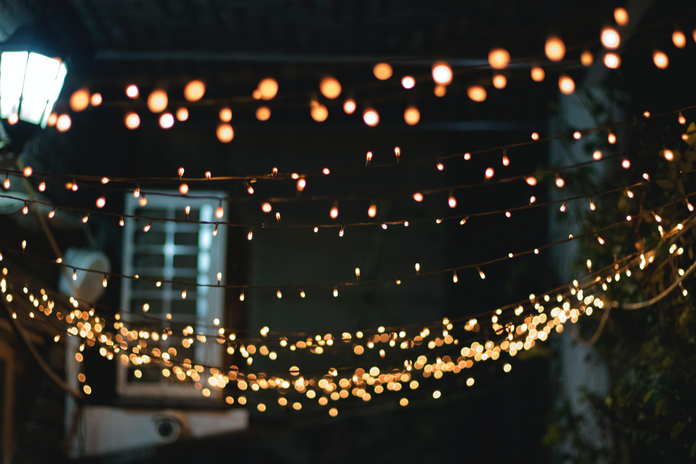The coming of October is accompanied by fairy lights plastered on public display in a room basic for any aesthetic-craving individual. Trees and street lamps too aren’t spared. Apart from being pretty, what makes fairy lights a ubiquitous decor element? Does our general fairy light behavior reveal something about consumption and transformation of aesthetics?
Millennials adore fairy lights or any type of ambient lighting including led panel lighting, golden hour lamp or light lamps in quirky shapes that liberally abound Instagram reels. A popular aesthetic combines polaroid pictures with string lights. This is not just an outcome of DIY culture and the silver/golden fairy lights with light leaking polaroids do give a retro feel. There has been a surge of retrograde aesthetics owing to the internet’s sonic boom. Unfortunately vintage is a mere filter. Aesthetics are purely for aesthetic’s sake. No value or attitude system embodies the contemporary resurgence of retro, boho, or 90s trends. Aesthetic understanding, and not intellectual understanding, is the focus of our exploration into the vintage past. Among millennials, nostalgia abounds for an age we haven’t been physically present in but that doesn’t mean that we haven’t experienced it. Period dramas and sitcoms give a kaleidoscope picture of the past. This creates a fragmentary popular perception of that era.
Style trends are outcomes of the time. Do we not have enough experiences to cultivate our own cultural ethos? In an era when systemic failures are at a zenith, vintage appears the best place to be. Internet facilitates the unbridled consumption of aestheticized images and ideals of the past. Maybe our rose-tinted nostalgic lens overlooks the societal hiatus of a vintage past. Ella Faust on Common Reader writes-
“When a teenager is asked “what decade do you wish you lived in?” their answer will most likely be solely based on the aestheticized idea that the internet has presented about this decade. If they say “the fifties,” they are most likely choosing this decade because of photos they have seen of stylish pink kitchens, long poodle skirts, and jukeboxes—not considering the severe social constraints on women, rampant racism, rising juvenile crime, the dislocation of urban renewal, and other social issues common to that era.
In contrast to this is the generally urban bourgeoisie concept of decorating houses with fairy lights. The lineup of lit houses is interesting and never fails at inspiring awe and creativity- blue, green, red and multiple colored lights instantly transport one to a Rajasthani motel. Neon blue and rose pink enact as trippy interiors of a hippie bus. They evoke dreadful images too. Blood-red lights or a house with silver lights shining alone in a long line of unlit houses stands as a perfect example for the same. Some hit your eyes with blinding brightness as if the bright colors weren’t enough for the lights to get noticed. Lastly, the one with Maggi status- golden lights have found a unanimous acceptance among settings as varied as a big fat Indian wedding, casual garden party, or a secluded reading corner.
Peer pressure is a layman’s guess of why everyone puts them on. With all the neighbors brightening their houses, you don’t want to be in the dark. Furthermore,fairy lights allow completely changing the look of one’s house without burning their pocket. They are versatile, durable and consume less electricity. It is no wonder that, unlike millennials, home owners have shed aesthetics of past like diyas or candles for modern inventions.
The idea of lighting the Christmas tree takes from a pagan tradition that rejoiced the onset of longer days post solstice. Functionality, comfort, and safety were celebrated. The invention and diffusion of fairy lights for the Christmas tree, then it’s use as a general Christmas decor item and the eventual replacement of standard diyas for Diwali shows how physical necessity gets overshadowed in the face of trends.
Our technologically charged environment lays out a cultural shop from which we may pick and choose any ware. While touring the house of a relative, I noticed how their Diwali decoration comprised of string lights, feet of Lakshmi’s sticker, rangoli, a disco ball-like light projecting multi-coloured hearts, a tribal lamp statuette and diyas. Hybridization might be called as the defining character of our era whether it is the hybridized nostalgia experienced by millennials or a wide range of hybridized decor elements.
Late Capitalism and Post-Modernism converge to summarize this effect. The former can be stretched to mean the latest which capitalism has to offer. The latter argues that systems and individuals are contingent; there’s no one universal or objective truth. Corporates and small sellers constantly try to understand us. A simple google search of “Why millennials love retro/fairy lights” would produce pages of tips advising sellers on how to tap into the millennial psyche. What we think is our aesthetic is externally produced and sold as our own creation or mental muse. In this sense, post-modernism is an illusion fueling capitalism.
The image of fairy lights goes beyond festivities as they accentuate the beauty of anything. Everything can have an aesthetic gaze. Even bricks and pebbles look pretty if appreciated( or marketed) closely. The question is- Is the gaze your taste or is it inspired by the status quo? The system disposes us to spend our money and emotions on frills. But more fundamentally, is it necessary to find meaning only in necessity? Can’t beauty be for beauty’s sake? Woke culture has shown that beauty is a matter of gaze. A gaze that has been politically exploitative and biased. We must ask, has beauty ever for beauty’s sake?


